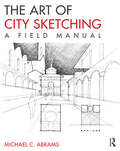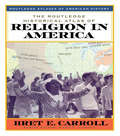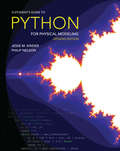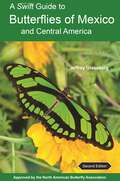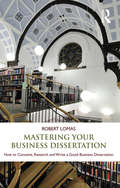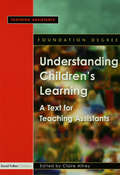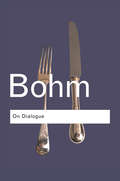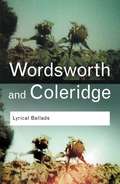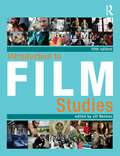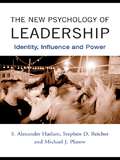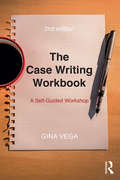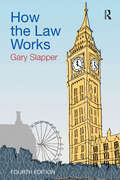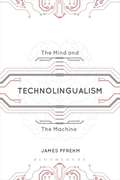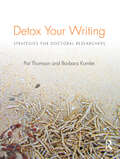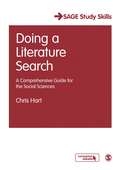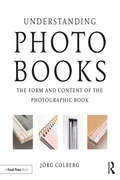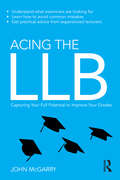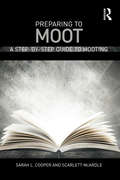- Table View
- List View
The Art of City Sketching: A Field Manual
by Michael AbramsThe Art of City Sketching: A Field Manual guides you through the laborious and sometimes complex process of sketching what you see in the built environment so that you can learn to draw what you imagine. Illustrated with hundreds of drawings by students and professionals of cityscapes around Europe and the United States, the book helps you develop your conceptual drawing skills so that you can communicate graphically to represent the built environment. Short exercises, projects, drawing tips, step-by-step demonstrations, and composition do's and don'ts make it easy for you to get out into the city and experiment in your own work. Author Michael Abrams uses his experience as a field sketching instructor, to show you that by drawing, you can discover, analyze, and comprehend the built environment.
The Art of City Sketching: A Field Manual
by Michael AbramsThe Art of City Sketching: A Field Manual guides you through the laborious and sometimes complex process of sketching what you see in the built environment so that you can learn to draw what you imagine. Illustrated with hundreds of drawings by students and professionals of cityscapes around Europe and the United States, the book helps you develop your conceptual drawing skills so that you can communicate graphically to represent the built environment. Short exercises, projects, drawing tips, step-by-step demonstrations, and composition do's and don'ts make it easy for you to get out into the city and experiment in your own work. Author Michael Abrams uses his experience as a field sketching instructor, to show you that by drawing, you can discover, analyze, and comprehend the built environment.
The Routledge Historical Atlas of Religion in America
by Brett CarrollFirst Published in 2001. Routledge is an imprint of Taylor & Francis, an informa company.
The Routledge Historical Atlas of Religion in America
by Brett CarrollFirst Published in 2001. Routledge is an imprint of Taylor & Francis, an informa company.
A Student's Guide to Python for Physical Modeling
by Jesse M. Kinder Philip NelsonA fully updated tutorial on the basics of the Python programming language for science studentsPython is a computer programming language that is rapidly gaining popularity throughout the sciences. This fully updated edition of A Student's Guide to Python for Physical Modeling aims to help you, the student, teach yourself enough of the Python programming language to get started with physical modeling. You will learn how to install an open-source Python programming environment and use it to accomplish many common scientific computing tasks: importing, exporting, and visualizing data; numerical analysis; and simulation. No prior programming experience is assumed.This tutorial focuses on fundamentals and introduces a wide range of useful techniques, including:Basic Python programming and scriptingNumerical arraysTwo- and three-dimensional graphicsMonte Carlo simulationsNumerical methods, including solving ordinary differential equationsImage processingAnimationNumerous code samples and exercises--with solutions—illustrate new ideas as they are introduced. Web-based resources also accompany this guide and include code samples, data sets, and more. This current edition brings the discussion of the Python language, Spyder development environment, and Anaconda distribution up to date. In addition, a new appendix introduces Jupyter notebooks.
A Swift Guide to Butterflies of Mexico and Central America: Second Edition
by Jeffrey GlassbergA groundbreaking photographic field guide to almost all of Mexico's butterfly species and many of Central America'sThis is a revised second edition of a groundbreaking photographic field guide to the butterflies of Mexico and Central America. Written by Jeffrey Glassberg, the pioneering authority on the field identification of butterflies, the guide covers more than 2,000 species and features over 3,700 large, gorgeous color photographs, the very best images available, accompanied by authoritative facing-page text. This second edition includes more species, more than 1,500 new photos, and updated text, maps, and species names. And range maps, field marks, and host plants are included for all Mexican butterflies. The result is an ideal field guide that will enable you to identify almost every butterfly you see.A revised second edition of a groundbreaking guide, featuring more species, more than 1,500 new photos, and updated text, maps, and species namesThe first complete guide to Mexican butterfliesCovers almost all of Mexico's more than 1,700 species, plus many Central American species, including more than two-thirds of those in Costa RicaWritten by the pioneering authority on the field identification of butterfliesBeautifully illustrated with more than 3,700 color photographs that highlight key identification featuresRange maps, field marks, and host plants for all Mexican speciesAuthoritative facing-page textAn invaluable tool for field identification
Mastering Your Business Dissertation: How to Conceive, Research and Write a Good Business Dissertation
by Robert LomasThe ability to write to a high standard is a key skill that is often overlooked in the business world. This short book from an international, best-selling author offers a practical guide to conceiving, researching and writing a business or management dissertation. Robert Lomas offers an inspirational treatise that will awaken the quest for knowledge among his readership. The book helps business students to frame their research questions in a more helpful manner in order to achieve their research aims and write in a clear and top scoring way. Topics covered include collecting and measuring data, using business statistics, planning research projects and the real mechanics of writing a dissertation. Masters students across business and management will benefit enormously from reading this book, not just in adding serious value to their dissertations, but also helping to improve their writing skills throughout their business careers. This book includes a foreword by Mark Booth.
Understanding Children's Learning: A Text for Teaching Assistants
by Claire AlfreyStructured to support teaching assistants, this pioneering textbook provides an academic underpinning to each of the key topics studied. The book: develops the theoretical knowledge needed to enhance work in the classroom; encourages students to reflect on their own practice; is in an ideal textbook format - full of tasks, questions, summaries and reading lists; and covers both primary and secondary years. Practical, easy-to-read and written specifically for teaching assistants, this book is also applicable for any trainee teachers or students of education.
On Dialogue
by David BohmNever before has there been a greater need for deeper listening and more open communication to cope with the complex problems facing our organizations, businesses and societies. Renowned scientist David Bohm believed there was a better way for humanity to discover meaning and to achieve harmony. He identified creative dialogue, a sharing of assumptions and understanding, as a means by which the individual, and society as a whole, can learn more about themselves and others, and achieve a renewed sense of purpose.
Lyrical Ballads
by William Wordsworth Samuel Taylor ColeridgeWhen it was first published, Lyrical Ballads enraged the critics of the day: Wordsworth and Coleridge had given poetry a voice, one decidedly different to that which had been voiced before. This acclaimed Routledge Classics edition offers the reader the opportunity to study the poems in their original contexts as they appeared to Coleridge’s and Wordsworth’s contemporaries, and includes some of their most famous poems, including Coleridge’s Rime of the Ancyent Marinere.
Lyrical Ballads
by William Wordsworth Samuel Taylor ColeridgeWhen it was first published, Lyrical Ballads enraged the critics of the day: Wordsworth and Coleridge had given poetry a voice, one decidedly different to that which had been voiced before. This acclaimed Routledge Classics edition offers the reader the opportunity to study the poems in their original contexts as they appeared to Coleridge’s and Wordsworth’s contemporaries, and includes some of their most famous poems, including Coleridge’s Rime of the Ancyent Marinere.
Introduction to Film Studies
by Jill NelmesIntroduction to Film Studies is a comprehensive textbook for students of cinema. This completely revised and updated fifth edition guides students through the key issues and concepts in film studies, traces the historical development of film and introduces some of the worlds key national cinemas. A range of theories and theorists are presented from Formalism to Feminism, from Eisenstein to Deleuze. Each chapter is written by a subject specialist, including two new authors for the fifth edition. A wide range of films are analysed and discussed. It is lavishly illustrated with 150 film stills and production shots, in full colour throughout. Reviewed widely by teachers in the field and with a foreword by Bill Nichols, it will be essential reading for any introductory student of film and media studies or the visual arts worldwide. Key features of the fifth edition are: updated coverage of a wide range of concepts, theories and issues in film studies in-depth discussion of the contemporary film industry and technological changes new chapters on Film and Technology and Latin American Cinema new case studies on films such as District 9, Grizzly Man, Amores Perros, Avatar, Made in Dagenham and many others marginal key terms, notes, cross-referencing suggestions for further reading, further viewing and a comprehensive glossary and bibliography a new, improved companion website including popular case studies and chapters from previous editions (including chapters on German Cinema and The French New Wave), links to supporting sites, clips, questions and useful resources. Individual chapters include: The Industrial Contexts of Film Production · Film and Technology · Getting to the Bigger · Picture Film Form and Narrative · Spectator, Audience and Response · Cinematic authorship and the film auteur · Stardom and Hollywood Cinema · Genre, Theory and Hollywood Cinema The Documentary Form · The Language of Animation · Gender and Film · Lesbian and Gay Cinema · Spectacle, Stereotypes and Films of the African Diaspora · British Cinema · Indian Cinema · Latin American Cinema · Soviet Montage Cinema of the 1920s Contributors: Linda Craig, Lalitha Gopalan, Terri Francis, Chris Jones, Mark Joyce, Searle Kochberg, Lawrence Napper, Jill Nelmes, Patrick Phillips, Suzanne Speidel, Paul Ward, Paul Watson, Paul Wells and William Wittington
Movie History: Second Edition
by Douglas Gomery Clara Pafort-OverduinCovering everything from Edison to Avatar, Gomery and Pafort-Overduin have written the clearest, best organized, and most user-friendly film history textbook on the market. It masterfully distills the major trends and movements of film history, so that the subject can be taught in one semester. And each chapter includes a compelling case study that highlights an important moment in movie history and, at the same time, subtly introduces a methodological approach. This book is a pleasure to read and to teach. Peter Decherney, University of Pennsylvania, USA In addition to providing a comprehensive overview of the development of film around the world, the book gives us examples of how to do film history, including organizing the details and discussing their implications.Hugh McCarney, Western Connecticut State University, USA Douglas Gomery and Clara Pafort-Overduin have created an outstanding textbook with an impressive breadth of content, covering over 100 years in the evolution of cinema. Movie History: A Survey is an engaging book that will reward readers with a contemporary perspective of the history of motion pictures and provide a solid foundation for the study of film. Matthew Hanson, Eastern Michigan University, USA How can we understand the history of film? Historical facts don’t answer the basic questions of film history. History, as this fascinating book shows, is more than the simple accumulation of film titles, facts and figures. This is a survey of over 100 years of cinema history, from its beginnings in 1895, to its current state in the twenty-first century. An accessible, introductory text, Movie History: A Survey looks at not only the major films, filmmakers, and cinema institutions throughout the years, but also extends to the production, distribution, exhibition, technology and reception of films. The textbook is divided chronologically into four sections, using the timeline of technological changes: Section One looks at the era of silent movies from 1895 to 1927; Section Two starts with the coming of sound and covers 1928 until 1950; Section Three runs from 1951 to 1975 and deals with the coming and development of television; and Section Four focuses on the coming of home video and the transition to digital, from 1975 to 2010. Key pedagogical features include: timelines in each section help students to situate the films within a broader historical context case study boxes with close-up analysis of specific film histories and a particular emphasis on film reception lavishly illustrated with over 450 color images to put faces to names, and to connect pictures to film titles margin notes add background information and clarity glossary for clear understanding of the key terms described references and further reading at the end of each chapter to enhance further study. A supporting website is available at www.routledge.com/textbooks/moviehistory, with lots of extra materials, useful for the classroom or independent study, including: additional case studies – new, in-depth and unique to the website international case studies – for the Netherlands in Dutch and English timeline - A movie history timeline charting key dates in the history of cinema from 1890 to the present day revision flash cards – ideal for getting to grips with key terms in film studies related resources – on the website you will find every link from the book for ease of use, plus access to additional online material students are also invited to submit their own movie history case studies - see website for details Written by two highly respected film scholars and experienced teachers, Movie History is the ideal textbook for students studying film history.
The New Psychology of Leadership: Identity, Influence and Power
by S. Alexander Haslam Stephen D. Reicher Michael J. PlatowWinner of the University of San Diego Outstanding Leadership Book Award 2012! Shortlisted for the British Psychological Society Book Award 2011! Shortlisted for the CMI (Chartered Management Institute) Management Book of the Year Award 2011–2012! According to John Adair, the most important word in the leader's vocabulary is "we" and the least important word is "I". But if this is true, it raises one important question: why do psychological analyses of leadership always focus on the leader as an individual – as the great "I"? One answer is that theorists and practitioners have never properly understood the psychology of "we-ness". This book fills this gap by presenting a new psychology of leadership that is the result of two decades of research inspired by social identity and self-categorization theories. The book argues that to succeed, leaders need to create, champion, and embed a group identity in order to cultivate an understanding of 'us' of which they themselves are representative. It also shows how, by doing this, they can make a material difference to the groups, organizations, and societies that they lead. ? Written in an accessible and engaging style, the book examines a range of central theoretical and practical issues, including the nature of group identity, the basis of authority and legitimacy, the dynamics of justice and fairness, the determinants of followership and charisma, and the practice and politics of leadership. The book will appeal to academics, practitioners and students in social and organizational psychology, sociology, political science and anyone interested in leadership, influence and power.
The New Psychology of Leadership: Identity, Influence and Power
by S. Alexander Haslam Stephen D. Reicher Michael J. PlatowWinner of the University of San Diego Outstanding Leadership Book Award 2012! Shortlisted for the British Psychological Society Book Award 2011! Shortlisted for the CMI (Chartered Management Institute) Management Book of the Year Award 2011–2012! According to John Adair, the most important word in the leader's vocabulary is "we" and the least important word is "I". But if this is true, it raises one important question: why do psychological analyses of leadership always focus on the leader as an individual – as the great "I"? One answer is that theorists and practitioners have never properly understood the psychology of "we-ness". This book fills this gap by presenting a new psychology of leadership that is the result of two decades of research inspired by social identity and self-categorization theories. The book argues that to succeed, leaders need to create, champion, and embed a group identity in order to cultivate an understanding of 'us' of which they themselves are representative. It also shows how, by doing this, they can make a material difference to the groups, organizations, and societies that they lead. ? Written in an accessible and engaging style, the book examines a range of central theoretical and practical issues, including the nature of group identity, the basis of authority and legitimacy, the dynamics of justice and fairness, the determinants of followership and charisma, and the practice and politics of leadership. The book will appeal to academics, practitioners and students in social and organizational psychology, sociology, political science and anyone interested in leadership, influence and power.
The Case Writing Workbook: A Self-Guided Workshop
by Gina VegaThis book offers a modular set of chapters that focus specifically on the challenges related to case writing. Exercises, worksheets, and training activities help guide readers sequentially through the entire process of writing both a case and an instructor’s manual (teaching note). Designed as an individualized workshop to assist case authors to structure their writing, this book combines the easy-to-understand, student-focused language of the first edition with new material covering the latest developments and challenges in the world of case writing. These include: ? A section on writing cases in condensed time frames ? A new module on writing short cases in various formats ? A new module on turning research papers into teaching tools ? A section about growing communities of practice in a university ? An expansion of the student case writing module to include a section on case writing for graduate students ? Twelve new worksheets ? A complete index to facilitate use of the book Finishing all the book’s assignments will result in a complete case and instructor’s manual that can be tested in the classroom and submitted to a conference or journal. The Case Writing Workbook is a must for the shelf of any academic or student conducting qualitative research and looking to enhance their skill set.
The Case Writing Workbook: A Self-Guided Workshop
by Gina VegaThis book offers a modular set of chapters that focus specifically on the challenges related to case writing. Exercises, worksheets, and training activities help guide readers sequentially through the entire process of writing both a case and an instructor’s manual (teaching note). Designed as an individualized workshop to assist case authors to structure their writing, this book combines the easy-to-understand, student-focused language of the first edition with new material covering the latest developments and challenges in the world of case writing. These include: ? A section on writing cases in condensed time frames ? A new module on writing short cases in various formats ? A new module on turning research papers into teaching tools ? A section about growing communities of practice in a university ? An expansion of the student case writing module to include a section on case writing for graduate students ? Twelve new worksheets ? A complete index to facilitate use of the book Finishing all the book’s assignments will result in a complete case and instructor’s manual that can be tested in the classroom and submitted to a conference or journal. The Case Writing Workbook is a must for the shelf of any academic or student conducting qualitative research and looking to enhance their skill set.
How the Law Works
by Gary Slapper‘How the Law Works is a gem of a book, for law students and for everyone else. It is a must read for anyone interested in how society is shaped and controlled via law.’ Dr Steven Vaughan, solicitor, Senior Lecturer, Birmingham Law School ‘How the Law Works is a comprehensive, witty and easy-to-read guide to the law. I thoroughly recommend it to non-lawyers who want to improve their knowledge of the legal system and to potential students as an introduction to the law of England and Wales.’ HH Judge Lynn Tayton QC Reviews of the first edition: ‘A friendly, readable and surprisingly entertaining overview of what can be a daunting and arcane subject to the outsider.’ The Law Teacher ‘An easy-to-read, fascinating book . . . brimful with curios, anecdote and explanation.’ The Times How the Law Works is a refreshingly clear and reliable guide to today’s legal system. Offering interesting and comprehensive coverage, it makes sense of all the curious features of the law in day to day life and in current affairs. Explaining the law and legal jargon in plain English, it provides an accessible entry point to the different types of law and legal techniques, as well as today’s compensation culture and human rights law. In addition to explaining the role of judges, lawyers, juries and parliament, it clarifies the mechanisms behind criminal and civil law. How the Law Works is essential reading for anyone approaching law for the first time, or for anyone who is interested in an engaging introduction to the subject’s bigger picture.
Technolingualism: The Mind And The Machine (PDF)
by James PfrehmSince the earliest days of our species, technology and language have evolved in parallel. This book examines the processes and products of this age-old relationship: a phenomenon we're calling technolingualism -- the mutually influential relationship between language and technology. One the one hand, as humans advance technology to master, control, and change the world around us, our language adapts. More sophisticated social-cultural practices give rise to new patterns of linguistic communication. Language changes in its vocabulary, structures, social conventions, and ideologies. Conversely-and this side of the story has been widely overlooked-the unique features of human language can influence a technology's physical forms and technical processes. Technolingualism explores the fascinating ways, past and present, by which language and technology have informed each other's development. The book reveals important corollaries about the universal nature of language and, most importantly, what it means to be human. From our first babbling noises to the ends of our lives, we are innately attuned to the technologies around us, and our language reflects this. We are, all of us, technolinguals.
Detox Your Writing: Strategies for doctoral researchers
by Pat Thomson Barbara KamlerThere are a number of books which aim to help doctoral researchers write the PhD. This book offers something different - the scholarly detox. This is not a faddish alternative, it’s not extreme. It’s a moderate approach intended to gently interrupt old ways of doing things and establish new habits and orientations to writing the PhD. The book addresses the problems that most doctoral researchers experience at some time during their candidature – being unclear about their contribution, feeling lost in the literature, feeling like an imposter, not knowing how to write with authority, wanting to edit rather than revise. Each chapter addresses a problem, suggests an alternative framing, and then offers strategies designed to address the real issue. Detox Your Writing is intended to be a companionable work book – something doctoral researchers can use throughout their doctorate to ask questions about taken-for-granted ways of writing and reading, and to develop new and effective approaches. The authors’ distinctive approach to doctoral writing mobilises the rich traditions of linguistic scholarship, as well as the literatures on scholarly identity formation. Building on years of expertise they place their emphasis both on tools and techniques as well as the discursive practices of becoming a scholar. The authors provide a wide repertoire of strategies that doctoral researchers can select from, rather than a linear lock step progression through a set of exercises. The book is a toolkit but a far from prescriptive one. It shows that there are many routes to developing a personal academic voice and identity and a well-crafted text. With points for reflection alongside examples from a broad range of disciplines, the book offers thinking tools, writing tools, linguistic tools, and reading tools which are relevant to all stages of doctoral research. This practical text can be used in all university doctoral training and composition and writing courses. However, it is not a dry how-to-do–it manual that ignores debates or focuses solely on the mechanical at the expense of the lived experience of doctoral research. It provides a practical, theorised, real-world, guide to postgraduate writing.
Doing A Literature Search: A Comprehensive Guide For The Social Sciences (PDF)
by Christopher HartDoing a Literature Searchprovides a practical and comprehensive guide to searching the literature on any topic within the social sciences. The book will enable the reader to search the literature effectively, identifying useful books, articles, statistics and many other sources of information. The text will be an invaluable research tool for postgraduates and researchers across the social sciences.
Doing Research (2nd edition) (PDF)
by Gary ThomasThis concise and easy-to-use guide provides students with the skills needed for planning and doing research well, whatever their course of study. Short, succinct chapters take students through the process one step at a time, from planning their project and doing the groundwork through to conducting fieldwork, analysing data and writing up their research. It features practical advice and examples from various subject areas throughout, alongside checklists to keep students on track. This is an ideal resource for students of all disciplines, especially undergraduates undertaking a research project for the very first time.
Understanding Photobooks: The Form and Content of the Photographic Book
by Jorg ColbergUnderstanding Photobooks is a user-friendly guide to engaging with the photographic book— or, as it is widely known, the photobook. Despite its importance as a central medium in which many photographers showcase their work today, there is surprisingly little information on the mechanics of the photobook: what exactly it does and how it does it. Written for makers and artists, this book will help you develop a better understanding of the images, concept, sequence, design, and production of the photobook. With an awareness of the connections between these elements, you’ll be able to evaluate photobooks more clearly and easily, ultimately allowing for a deeper and more rewarding experience of the work.
Acing the LLB: Capturing Your Full Potential to Improve Your Grades
by John McGarryOften law students don't achieve the results they are capable of, not because of a lack of intellectual ability, but because they haven’t fully understood what is required of them and what they could and should do to achieve higher marks. Acing the LLB will help those students realise their full potential and achieve the very best marks. It explains what lecturers are looking for in a top class answer and is packed with easy-to-follow practical advice that students can use to improve their performance. The author draws upon his own experiences as a lecturer and marker of student work as well as those of colleagues at a range of institutions to offer sound and realistic advice. Engaging, accessible and very readable, this is an ideal guide for anyone starting out on an LLB or for current law students who are looking to improve their grades.
Preparing to Moot: A Step-by-Step Guide to Mooting
by Sarah L. Cooper Scarlett McArdleMooting is an increasingly important activity in UK law schools. This is because mooting offers students the opportunity to develop advanced analytical, research, drafting and advocacy based skills, which help to improve their general academic achievement and employability profiles. Tangible evidence of these skills is invaluable in a progressively competitive job market. The ideal guide for the first-time mooter, Preparing to Moot provides an accessible, systematic and pragmatic approach which demystifies the process. It focuses on analysis, research and argument construction as the foundations for successful advocacy and provides students with a working guide to use alongside moot problems in five popular topic areas: criminal law, contract law, tort law, human rights and the law of equity. Through careful use of annotated examples generated by real students, and expert tips and advice from the authors, the book shows students how to individually analyse, research and construct arguments for various advocate positions, providing a practical and easy-to-follow overview of how to tackle a moot from analysing a problem initially, right up to beginning to advocate.
